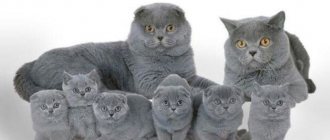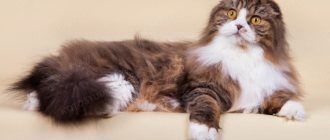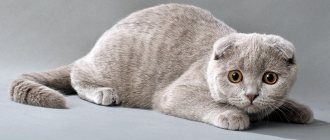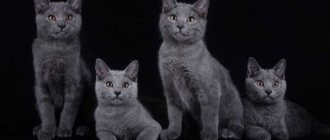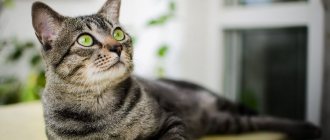History of the Scottish Straight cat breed
Scottish Straight cat
Scottish Straight are the same Scottish folds, but with a modified position of the ear. Straight ears do not have a characteristic crease and are set straight, and this, in fact, is the only external sign that distinguishes them from their fold-eared counterparts. Scottish cats are considered one of the youngest cat breeds. The first cat with an unusual, flattened ear shape appeared on a Scottish farm in the early 60s. Surprisingly, the ancestor of modern folds and straights had no pedigree and simply chased mice through the barns of local peasants.
The first official Scottish breeder was an ordinary villager, William Ross, who adopted a kitten from the aforementioned Fold. A few years later, professional breeders also joined the process. At the same time, experts witnessed an interesting phenomenon: in the litters brought by even the most purebred Scottish dogs, babies with erect ears appeared. Of course, no one intended to separate such individuals into a separate breed. And kilometer-long queues did not line up for straight-eared kittens, because against the backdrop of touching folds, they were outright losing. But here nature itself intervened.
Very soon, Scottish breeders noticed that attempts to strengthen and strengthen the lop ears of animals had a negative impact on their health. The mutated gene responsible for the flatness of the ear folds began to inhibit the function of the skeletal apparatus of cats. As a result, the Scots began to suffer from thickening of the bones and osteochondrodysplasia. To keep the breed afloat, breeders rushed to look for “new blood” that would help the Scottish survive and reduce the number of their genetic defects. Through trial, error and outcrossing, it was discovered that the healthiest and most beautiful offspring can be obtained from crossing a Fold cat and a straight-eared male of the same breed. It was thanks to this discovery that breeders and felinological associations finally turned their attention to straight-eared Scots. Well, in 2004, the Scottish Straight subspecies received official recognition from the World Cat Federation and the status of an independent breed, which sharply increased the attractiveness of straight-eared cats in the eyes of potential buyers.
What is the difference between a Scottish cat and a British cat: what is the difference between these breeds
Photo from the site arnold-bs.ru
Folds have small and forward-curved ears. They are practically invisible, so kittens of this breed look a little like an owlet. The main differences between straight-eared Scottish cats and British ones are that:
- they are lighter and more elegant;
- their head shape is more round;
- the body is more elongated.
The average weight of a fold and straight is 3-3.5 kilograms, and a cat is only 4-5 kg, which is significantly less than that of the British.
You can often hear cats with floppy ears called “British Folds.” But such a breed does not exist! British Shorthairs are a separate breed that has its own standards.
At the moment, breeders have clearly separated and differentiated these species, but occasionally allow the crossing of Scots with British in their breeding program. This allows you to get a rare color. Their aimless matings are impractical, as they spoil the breed type of Scottish.
Photo from murkote.com
Appearance of the Scottish Straight
Scottish Straights can easily be confused with the British, although representatives of these two breeds have a minimum of common genes. Scottish Straight cats are much smaller than their competitors from Albion, although they have a longer body. The weight of an average straight is 3-3.5 kg. Modern breeders are still wondering what kind of offspring they will get after mating a fold and a straight, since initially all kittens are born with ordinary ears, which change their position only at the end of the first month of life.
Head
Mustachioed Scotsman
According to the WCF standard, Scottish Straights must have a rounded skull. Representatives of this breed have convex foreheads and cheeks. In cats, the area of the cheekbones and cheeks is noticeably more rounded than in cats. The chin of the Scots is firm, rounded, but does not protrude forward. The whisker pads are distinguished by their characteristic “swelling” and have the shape of a regular oval.
Nose
Wide and short, with a slight arch of the back and a pronounced base, practically without a stop.
Eyes
Large and round, widely spaced. The gaze is open, inquisitively focused. Eye color depends on the coat color of the animal.
Ears
Erect, small, with a wide base. The tips of the ears are rounded and point forward. The outer part of the ear is covered with thick, close-fitting hair. The inner part is decorated with lush and stiff hair brushes extending beyond the edge of the ear.
Neck
The Scottish Straight cat has a muscular and short neck.
Scottish Straight muzzle
Frame
Moderately long, muscular and wide, tending to the rectangular type. The silhouette line is soft and rounded.
Limbs
Proportional to the body, that is, moderately long and strong, with developed muscles. The paws are oval, the toes are tightly clenched.
Tail
Medium or long, mobile, reaching to the middle of the shoulder blades.
Wool
Scottish Straight tabby color
Short or semi-long (in Highland individuals). Double, plush type, with well-developed undercoat. It does not adhere to the body, but covers it tightly. The texture of the coat may vary slightly depending on the season, as well as the type of color of the animal.
Color
The standard allows all types of colors found among representatives of this breed. The most typical color options for Scottish Straight cats are solid, bicolor, point, tabby, particolor, chinchilla, ticked, van and shedded.
Defects in appearance and disqualifying defects
Individuals with semi-erect or too wide ears with a British set are considered not the most successful representatives of their breed. The flat forehead, pronounced stop, long legs and small eyes of the Scottish Straight are also not decorative. Animals with an insufficiently long, inactive and kinked tail, cryptorchidism and everted toes are subject to unconditional disqualification. Weak and sick cats are also not allowed to participate in exhibition events.
Kittens from a Scottish Fold cat, with an average of five straight-eared and one fold-eared
Description
Everyone has at least once seen a blue Scottish Fold cat on the Internet, their photos are incredibly popular there, so this description will be familiar to you.
The main difference from other breeds is, of course, drooping ears; this feature became the breed-forming feature. Cats of this breed are similar to plush toys in both their appearance and character, but more on that later.
The weight of Scots varies greatly depending on the sex of the animal: females weigh 4-5 kg, and males reach the level of 10 kg. They have a short and strong neck, on which there is a spherical head with flattened ears and a humped nose.
The paws are massive, but not very long, but this does not in the least interfere with the animal’s mobility. The fur is short and dense, which is why these cats are often compared to plush toys. The tail is wide, but short, while tapering towards the end.
Look - Siberian cat - description, content, breed standard, character and intelligence of the cat (90 photos + video)
Note!
Norwegian Forest Cat - description of the breed, character, habits and maintenance of the Norwegian (110 photos and videos)
- Cat litter - detailed review, prices, how to choose, where to buy
Ragdoll - 110 photos, breed description, price, character and owner reviews
Scottish Folds come in a variety of colors, from solid to striped, so you can find almost any coat pattern.
Scottish Straight character
It would be a big mistake to label all Scottish Straights as phlegmatic philosophers. Moreover, among these imposing cats, sometimes there are real livelies who love to chase a wind-up mouse and measure their strength with the owner. And yet, for the most part, Scottish straight cats do not have a violent temperament. Proud and serious, they cannot stand total control and are unlikely to allow themselves to be squeezed into a semi-conscious state. This, of course, does not make Scottish ascetics and sad hermits, they just require a little more independence and personal space than representatives of other breeds. Straights prefer to spend their free time in peace and quiet, lounging on the couch and learning Zen in the Buddha pose.
Squeezing the cat
The Scots are happy to make contact and join in the games, but only when they want to. In all other cases, it is better to leave the cat alone. The peak of motor activity of straight-eared Scottish cats occurs in the first year of their life. By the way, Scottish babies in their playfulness and restlessness are practically no different from ordinary outbred kittens. Adults, on the contrary, are famous for their exemplary behavior and patience. If you go on a visit for a couple of hours, leaving the Straight alone, he will easily survive it. However, weeks of loneliness, interrupted by rare raids from the owner, will not improve the character of the animal. As for the pacifying purr of straight-eared Scottish cats, it still needs to be earned: cats purr infrequently, and meow only in exceptional, from their own point of view, cases. Scottish Straights accept strangers and noisy groups of guests in a completely “secular” way, which means without unnecessary suspicion and aggression, but also without wild delight.
Scottish Straight cats are emotionally stable and not subject to sudden mood swings. However, exceptions to the general rule have not been canceled, so amateur videos with catchy headlines like: “The most disgruntled Scottish in the world” periodically appear on the Internet. In addition, straights are characterized by amazing persistence. If a cat wants something, he will definitely achieve it, following on the heels of the owner, and sometimes reinforcing his actions with annoying meows.
Training and education
Scottish Straight
Intelligent by nature, Scottish Straight cats are easy to educate and very difficult to fully train. Teaching a Straight to use a litter box and a scratching post is not at all difficult, provided that this process was started in time, before your pet matures. By the way, young Scottish cats are active and sometimes uncontrollable, so in the first months of the baby’s life you will have to put up with the inevitable destruction in the house.
Even if the fame of Yuri Kuklachev haunts you, it’s better not to get carried away with the serious drill of straights. Whatever the experts say, unquestioning obedience to commands is not the strong point of Scottish straight-eared cats. Instill in your pet the basics of etiquette and teach him to respect subordination - this will be quite enough. As for a full-fledged training program, save it for show-class individuals, who will later have to demonstrate their talents at exhibitions.
- If the animal allows itself too much, try to stop it with the command “No!”, which is given in a stern and loud voice.
- If the kitten does not respond to a stern tone, grab it by the scruff of the neck and imitate a cat hissing. The baby will understand this language faster.
- Do not try to poke the kitten's muzzle into the puddle it has made or try to hammer the basics of cleanliness into it with a slipper. After suffering stress, the cat will definitely play a mischief in another place, but this time it will be reliably hidden from you.
- Have you noticed that your plush beast is sitting in an unambiguous position on the carpet or trying to steal food from the table? Scare him with a loud whistle or clap of your hands. Make no mistake, fear is a very powerful educational tool.
- Never scold or praise a Scottish Straight cat after the fact. Despite a fairly high level of intelligence, the animal is not able to connect together yesterday's exemplary behavior and today's reward.
Color classification
A classification has been developed that divides the colors of animals of this breed into the following groups:
- solid;
- bicolor;
- tortoiseshells;
- tabby;
- tipped;
- color point, etc.
Solid colors
This group includes cases when the animal’s fur is uniformly colored with one rich color.
The main solid colors are:
- blue;
- white;
- chocolate;
- lilac;
- black;
- cream;
- red.
White wool indicates the absence of the gene responsible for color. Pure white cats, as well as albinos, are extremely rare. At birth, they may have blue or black spots for a short period, which later disappear.
The eyes of Scottish cats with white fur may have a gray or amber tint. There are individuals with irises of different colors.
The Scottish Fold Lilac was recently developed and is considered rare. This group includes animals with light fur with a pinkish, deer, or lilac tint. Changes in color intensity are undesirable.
Scottish Fold solid color.
Solid black cats are rare. The presence of brown and red spots, as well as a grayish tint, is not allowed. Fold-eared and straight-eared cats often have a blue coat color. This category includes animals whose fur has a light gray tint. Some kittens have a pattern, but it disappears when they shed.
Scottish red cats are extremely rare. Such animals are distinguished by solid fiery red fur. The earlobe and pads are red. A faded pattern is allowed on the paws, forehead and tail.
Cream coloring is common among Scots. The animals have a reddish coat and a peach-colored undercoat. A vague pattern on the head in the forehead area is allowed, but the presence of leopard markings is unacceptable.
The Scottish Fold chocolate is rare. The shade cinnamon is especially rare. Brown fold kittens should have uniform fur color.
Bicolors
The bicolor color of Scottish cats combines a main blue, black, chocolate or other color with white spots or areas with tipped, tortoiseshell or tabby coloring.
Common varieties of bicolor colors include:
- bicolor;
- van;
- harlequin;
- calico.
Scottish bicolor cat.
In Scottish Harlequin cats, approximately 1/5 of the coat is light in color. The tail is dark by standard. There are colored spots on the sides, back, paws and head. It is desirable that they be symmetrical. Van colored cats have almost the entire body surface covered with white hair. Only the tail is bright orange or chocolate color.
Scottish bicolor cats have approximately ½ of their body covered with white hair. White areas are located on the ends of the paws, chest, belly, neck, chin and muzzle. It is good if there is a closed white collar around the neck.
Calico combines white areas and tortoiseshell areas. According to the standard, the ends of the paws and chest should be covered with white hair.
Tabby
The colors of Scottish Fold tabby cats are distinguished by the presence of a clear zonal pattern that stands out against the main background color.
Commonly encountered varieties are:
- marble;
- ticked;
- brindle;
- spotted
Brindle color of the Scottish cat.
Cats with a merle color have a butterfly pattern on their shoulders, 3 longitudinal stripes on their back, and symmetrically located spots and streaks on their belly. Dark markings against the background of the cream main color, as well as on silver, are rare.
The ticked version is distinguished by a zonal and uniform shade of each hair. Multi-colored stripes alternate, creating a shimmer. The golden ticked color is the rarest.
The brindle color suggests that against the background of the main color there are vertical stripes located on the sides. A dark line runs along the spine and tail.
Spotted Scottish cats have a dark stripe along the spine. There are a large number of dark spots on the sides. Horizontal stripes are visible on the paws, and light-colored fur on the belly.
Tortoiseshell colors
Tortoiseshell colors are characterized by a combination of areas of cream, black and red.
The following varieties are often found:
- black-red;
- blue-cream;
- chocolate red;
- lilac-cream.
Tortoiseshell Scottish cat.
Tortoiseshell black and red cats have a large number of bright red-brown spots on a mostly dark background. There are especially many of them on the head, the outside of the paws, the back and the tail. Chocolate red tortoiseshell cats have many light round spots of red and beige on a brown background.
The blue and cream tortoiseshell cat is a tricolor cat. There are rounded cream and gray spots on a white background. They are located on the sides, back and head of the animal. The paws, chest and belly are white. In tortoiseshell cats of the lilac-cream variety, cream and purple inclusions dilute the white background. The chest and front legs of the animals are white.
Tipped colors
In cats of typed color, the pigment is unevenly distributed along the length of the hair. The area near the root is not pigmented, but the ends are intensely colored.
Types of tipped colors:
- chinchilla;
- shaded;
- smoky.
Scottish cat of tipped color.
With the chinchilla color variant, only 1/8 of the length of the hairs is pigmented, and the rest is white. There are several subspecies, including blue, silver, and gold.
In the smoky version, the base of the hairs is silver and the ends are black. The coloring of such animals is called black smoke.
Color point
Scottish cats of this color have a light base coat, but there are dark spots on the ends of the paws, tail, muzzle and ear area.
Common color varieties include:
- blue point;
- cream point;
- lilac point;
- cake point.
Color point color of a Scottish cat.
Rare varieties include cream-point animals . In such creatures, against the background of a light beige body shade, areas of a dark cream color stand out. Tortoy point cats have dark brown and cream areas on a light background. Lilac point cats have bright lilac spots on a white background. In Blue Point cats, blue areas stand out against a light background of body fur.
Care and maintenance
Scottish Straights are typical domestic cats for whom walks in the fresh air are pleasant entertainment, but not more than that. This is why Scots are considered ideal pets for homebodies. In everyday life, straights are unpretentious and rarely cause trouble. Take your animal for routine veterinary examinations, carry out timely vaccinations, use high-quality food - and straight-eared Scottish cats will not create any problems for you.
Hygiene
Scottish Straight loves his mistress
Scottish Straights are very clean cats that carefully monitor the condition of their own fur, but they still need to be bathed from time to time. Usually, cats are washed as their “coat” gets dirty, using shampoo from the pharmacy. At the end of the procedure, you can apply a balm to the coat. When bathing, make sure that water does not get into the animal’s ears and be sure to protect the wet pet from drafts.
Owners of show-class specimens preparing to participate in exhibitions will have to work a little harder. In particular, a few months before the event, the cat begins to be washed daily to completely remove dead cells from its skin and stimulate the growth of new fur. In addition, you will have to spend money on a variety of professional coat care products, ranging from degreasing paste to texturizing conditioner. Brush Scottish cats once a week with a short hair brush. Claws are trimmed as they grow. Be sure to monitor the condition of your cat's eyes and remove unwanted discharge with a swab soaked in hygiene lotion.
Feeding
The diet of Scottish Straights is no different from the “menu” of their fold-eared counterparts. Just like folds, Scottish straight-eared cats benefit from lean meat, offal, boiled sea fish, fermented milk products, and egg yolk. In addition, the animal’s diet should include vegetables (raw or stewed), cereals and sprouted wheat.
Prohibited
- Fat meat.
- Beans and potatoes.
- Bones.
- Sweets, spices, smoked foods.
- Garlic and onion.
- Bread.
- River fish.
- Citrus.
- Mushrooms.
- Raw eggs.
Curious Scottish Straight
In serious nurseries, Scottish Straight kittens are sold starting from the age of three months. During this period of life, the baby no longer feeds on mother's milk, which means it is able to eat the same food as an adult animal.
An important point: natural-fed straight cats do not receive enough of the vital microelements. Vitamin and mineral complexes, which can be purchased at a veterinary pharmacy, solve this problem.
Scottish Fold cats can also be fed commercial food if you are willing to spend money on its non-budget varieties - “premium”, “super premium” and “holistic”. An ideal cut for a Scottish dog should contain at least 26% protein and about 9% fat. It is advisable that the food does not contain wheat and corn, which can cause allergies in the cat. From this point of view, the most useful options for “drying” can be considered the Canadian Acana Pacifica Cat and the American Earthborn Holistic.
Three-month-old Scots are fed up to 6 times a day, six-month-old kittens eat 5 times a day, nine-month-old kittens - 4 times. One-year-old individuals are considered adults, so 2-3 meals are enough for them.
Health and disease of the Scottish Straight cat
Scots live up to 15-20 years of age without much difficulty, but only if they were properly cared for and mandatory veterinary procedures were not neglected. Unlike folds, straights have practically no genetic mutations or hereditary diseases, so representatives of this breed are relatively healthy animals with good immunity. As for diseases of the gastrointestinal tract and genitourinary system, sometimes diagnosed in straight-eared Scottish cats, they are most often caused by poor nutrition.
How to choose a Scottish Straight kitten
Arm yourself with the breed standard and visit a Scottish Straight breeder in an informal setting to see with your own eyes the conditions in which the kittens grow up. Well-groomed Scottish dogs have lush, shiny coats and clear, open eyes. The abdomen of a normally developing baby is soft, and not swollen to the point of a ball. A healthy kitten's tail should be clean, and its fur should not smell bad or sparkle with bald spots.
Observe the behavior of the young Scottish Straight. A trouble-free baby willingly joins in the gameplay and shows interest. Kittens that are bored and unresponsive are most likely unhealthy or depressed. Observing the character of the babies’ parents is also a good safety net, since it is from them that the animals inherit their temperamental characteristics.
Video
* We invite you to watch a video about the Scottish Straight cat . In fact, in front of you is a playlist in which you can select and watch any of 20 videos about a given cat breed by simply clicking on the button in the upper right corner of the window. In addition, the material contains quite a lot of photos. By looking at them you can find out what a Scottish Straight cat looks like.
In this article:
|
Rate the material!
[Total votes: 8 Average: 4.6]
The Scottish Straight cat has gained enormous popularity in just half a century. These affectionate, inquisitive and good-natured cats easily get along in a variety of families. They do not require serious care and special educational methods: Scottish Straight cats are smart and easy to train.

